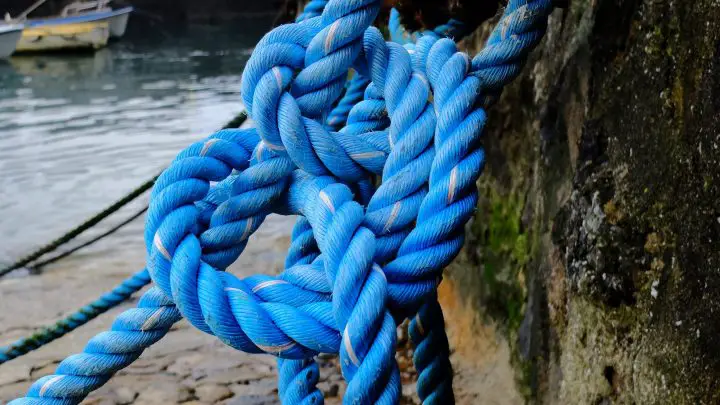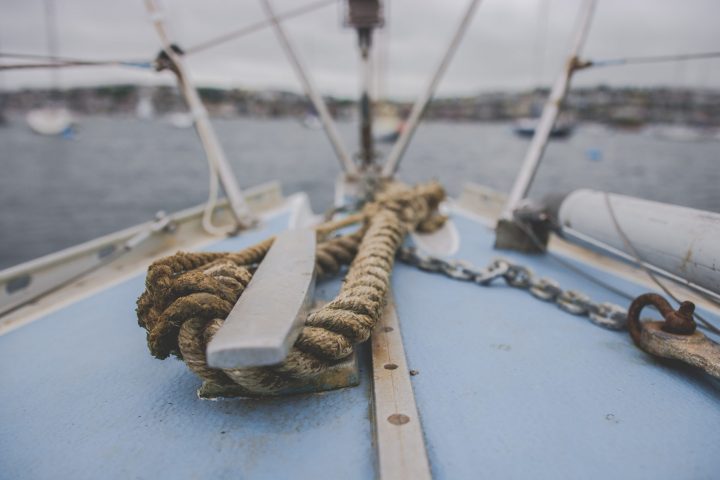Boat knots intimidate a lot of would-be boaters. Some people even avoid sailboats altogether simply because they can’t get their heads around how to tie knots and handle so many lines. But it is not that complicated, so don’t let line handling or knot tying worry you too much if you’re starting out.
Remember, knot tying isn’t just for sailors, though. Every boater needs to know a few critical knots because every boat uses lines for tying up at docks, flying flags from halyards, securing fenders for docking, or anchoring.
One other thing–knot tying is a hobby in itself. While some people are interested and want to learn more, there are only a handful of essential knots you need to know. They’re pretty simple, and anyone can learn them in an afternoon of practice.
Table of Contents
- Basic Marine Knot and Sailing Terms
- Why It’s Important to Get It Right
- Three Essential Sailing Knots Everyone Should Know
- A Few More Boat Knots That Will Come In Handy
- Knot the End

Basic Marine Knot and Sailing Terms
Learning about line handling and the best sailing knots involves some terms that might be new. Here are a few definitions to get started.
Rope Versus Line
Most boats have no rope but many lines. Say what? Technically, a rope is “unassigned cordage.” If you go to West Marine and browse the spools of cordage, you are looking at a rope. It hasn’t been cut or given a job yet.
A line has a purpose on your boat. At the store, they also sell pre-packed dock lines. They have been cut and have a purpose–to be mooring lines.
Bitter End
The bitter end is the loose end of the line. It’s sometimes called the working end because it is this part that you maneuver to tie a knot.
Standing End
In contrast, the standing part is the part that you don’t work with. Perhaps it’s attached to hundreds of feet of halyard, or it’s already tied to something. Basically, the standing end remains stationary, and the bitter end gets moved around to tie the knot.
Knot
A knot is used to form an eye. Maybe you need an eye in the line to throw it over something, or maybe you need to secure the line around something with a big loop. For example, you could make a large eye to throw over a piling.
Hitch
The better option, however, is a hitch. A hitch secures the line to an object, like a piling, ring, railing, or mast.
Bend
Bends secure two lines together. There are a few types, and the width of the line can be the same or different depending on which you use.
Splices
Splices are different than knots because they do not involve tying the line. Instead, the line is disassembled and reconfigured to be joined to another piece of line or to add a loop in the end.
Splices are much stronger than any other form of line work. But properly creating a splice takes a lot more time and usually some extra equipment.
Splices are often used on permanent lines that need to be attached to something else. For example, anchor lines are typically spliced to the chain or into an eye for a shackle.
Why It’s Important to Get It Right
Here’s the thing about tying these types of basic knots—some are easy to screw up. So you must learn to tie the perfect knot the first time and check your work.
Proper knot tying is essential for two reasons. For one, if it’s done wrong, the knot can slip and fail.

Next, there’s the issue of strength. All knots will reduce the strength of a line, some by more than half! Tying a sailers knot incorrectly can reduce the line’s load limit even more. However, a properly tied bowline, for example, will retain as much as 70 percent of the line strength.
Three Essential Sailing Knots Everyone Should Know
You will have a solid start on your boating future if you start with the three knots below and learn to tie them well.
Bowline Knots — The King of Knots
Pronounced “BO-len,” it’s been described as the king of knots because it is so darned useful!
A bowline knot creates a fixed loop at the end of a line. But you’d be shocked at how useful that is. Need to secure your anchor line? A bowline is just the thing. If your shackle loses its pin, and you need to attach a halyard to hoist your sails, a bowline will do the trick.
Maybe the neatest thing about the bowline is that the loop is not permanent. Even after a bowline has been tied in a line for years, it’s easy to take it out.
Cleat Hitch
Cleats are everywhere—they’re on your boat and most docks you visit. Every boat has to deal with cleats, and therefore every boater should know how to tie a proper cleat hitch.
The proper cleat hitch is—for lack of a better word—a hitch! If the line is pulled on, the hitch constricts on itself to prevent it from letting go. If the hitch is not tied correctly, the line can begin pulling off of the cleat.
Round Turn and Hitches
The final sailor knot everyone should have is the round turn and two half hitches. It’s used to secure the line to a fixed object. For example, you could use it to tie to a piling or attach a fender to a railing.
A Few More Boat Knots That Will Come In Handy
There will come a time when you need a knot, and none of the three above will do. The right knot is out there–you might have to look it up and learn it.
Stopper Knot — Figure Eight Knot
Sometimes you really don’t want to lose a line. For example, if you let your halyard fly freely, it might run so far that it goes up and into the mast. It’s nearly impossible to retrieve—so don’t let that happen! Use a stopper knot instead.
There are a few different types, but the most straightforward to tie is the figure-eight knot. All it does is make a stopper on the working end so that it cannot pass freely through a rope clutch, block, or fair lead.
Reef Knot or Square Knot
These knots are used to join two lines together. On some sailboats, this is used when you reef the sail. First, the sail is lowered. Then a series of small lines are joined together from each side of the sail, running around the boom.
It’s also called a square knot because it looks roughly square as you are tying it.
This secure knot is the perfect example of there being a right way and a wrong way to tie a boaters knot. If you tie this knot improperly, you get what is often called the “granny knot.” Those are nearly impossible to undo, yet they can slip and are unreliable if you pull tightly.
Clove Hitch
A clove hitch is another way of attaching a dock line to a piling, at least temporarily. The line is wrapped around the post, but it is done so that if it is pulled on, the hitch gets tighter and tighter.
Like the square knot, an improper clove hitch will slip and fail. Therefore, you must double-check clove hitches and ensure they’re secure, especially when using them for something important like dock lines.
Rolling Hitch
Finally, the rolling hitch is a way of attaching one line to another. It’s beneficial if you need to take the load off of one line to fix something that has gone wrong.
One common use is in anchoring. You can use a rolling hitch to attach a nylon snubber line to your anchor chain.
Sailors can also use the rolling hitch if they inadvertently jam a winch. A winch jam is impossible to fix when there is tension on the line. So you can use a rolling hitch to connect a second line and remove the tension from the jammed line.
Knot the End
In knot tying, it’s often the case that there is more than one way to get the job done. But it’s also true that there is a proper knot for every task to get it done. What is much more important than knowing every knot by heart is knowing where you can go for a good tutorial when you need one.
This list is just a starting point, but it will likely meet most of a boater’s needs. Like many good adventures, the more boating you do, the more tricks you’ll learn along the way.
What is a good knot for sailing?
Every sailor and boater should know a few different knots. At a minimum, they should be familiar with tying a bowline, cleat hitch, and round turns and hitches.
These three knots will get you started and meet a majority of your needs while sailing. As you gain more experience, you’ll find more knots you’ll want to learn as you go along.
What knot is used to tie up a boat?
The knot you use to tie up to a dock depends on how the dock is set up. For example, many docks have cleats, in which case the cleat hitch is the knot of choice.
On the other hand, you might only have pilings to tie to. In that case, there are numerous ways to tie to it. You could tie a simple bowline to create a loop in the line that goes over the piling. You then run the line’s working end back to your boat and adjust its length on the boat’s cleat with a cleat hitch.

